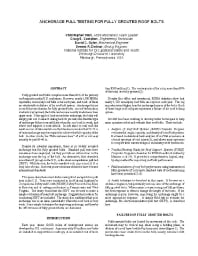Mining Publication: Anchorage Pull Testing for Fully Grouted Roof Bolts
Original creation date: August 2002
Authors: C Mark, CS Compton, DC Oyler, DR Dolinar
NIOSHTIC2 Number: 20023135
Proc 21st Intl Conf on Ground Control in Mining. Morgantown, WV: West Virginia University, 2002 Aug; :105-113
Fully-grouted roof bolts comprise more than 80% of the primary roof supports used in U.S. coal mines. However, nearly 1,500 MSHA reportable, non-injury roof falls occur each year, and most of these are attributable to failure of the roof bolt system. Anchorage failure is one failure mechanism for fully-grouted bolts. As roof deformation works its way upward, the bolts can become heavily loaded near their upper ends. If the applied load exceeds the anchorage, the bolts will simply pull out. Research dating back 30 yrs indicates that this type of anchorage failure is most likely when the roof rock is weak, just where roof support is most critical. In soft shale or coal roof, the small amount of data available in the literature indicates that 20-30 in of resin anchorage may be required to achieve the full capacity of the bolt. In other words, the "full resistance zone" of a 60 in bolt may actually be just 30-40 in. Despite its potential importance, there is no widely accepted anchorage test for fully grouted bolts. Standard pull tests have sometimes been employed, but they provide no information on the anchorage near the top of the bolt. An alternative, first described more than 25 yrs ago in the U.S., is the short-encapsulation pull test (SEPT). With this test, the bolt is installed with only a short (1 ft or less) tube of resin. In recent years variations of this test have become international standards. This paper describes recent studies using short encapsulation pull tests in the U.S. Tests were conducted in the National Institute for Occupational Safety and Health (NIOSH) Safety Research Coal Mine at Bruceton and at underground mines in Pennsylvania and West Virginia. The study found that the SEPT can be used to make a simple evaluation of resin bolt anchorage. Suggested procedures for conducting SEPT are included. The study also confirmed that poor anchorage can be an issue, particularly where the roof rock is very weak. Some simple techniques for improving anchorage, and thereby the effectiveness of fully grouted bolts, are discussed.

NIOSHTIC2 Number: 20023135
Proc 21st Intl Conf on Ground Control in Mining. Morgantown, WV: West Virginia University, 2002 Aug; :105-113
- Diagnosing and Controlling Moisture-Sensitive Roof in Coal Mines
- Dynamic Failure in Deep Coal: Recent Trends and a Path Forward
- Field Performance Testing of Fully Grouted Roof Bolts
- Geologic Hazards and Roof Stability in Coal Mines
- Investigation of Fully Grouted Roof Bolts Installed Under In Situ Conditions
- Make it Safer with Roof Screen
- Optimizing Secondary Roof Support with the NIOSH Support Technology Optimization Program (STOP)
- Overview of Coal Mine Ground Control Issues in the Illinois Basin
- Roof Screening: Best Practices and Roof Bolting Machines
- Technology News 483 - Safety Training Tools for Rock Scaling Personnel